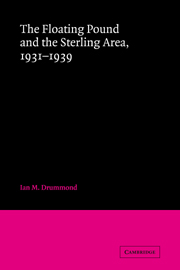Book contents
- Frontmatter
- Contents
- Preface
- 1 Introduction: the sterling area in the 1930s
- 2 Sterling and the rupee
- 3 The Canadian debate over money and exchanges, 1930–1934
- 4 South Africa, sterling, and the gold standard, 1931 and thereafter
- 5 Australia and New Zealand, 1930–1939
- 6 Monetary preparations for the World Economic Conference
- 7 United Kingdom policy at the World Monetary and Economic Conference
- 8 Talking about exchange stabilization, autumn 1933 through June 1936
- 9 The Tripartite Agreement of 1936
- 10 Intergovernmental conversations and the management of sterling, 1936–1939
- 11 Conclusion: the significance of sterling
- Notes
- Index
5 - Australia and New Zealand, 1930–1939
Published online by Cambridge University Press: 07 October 2011
- Frontmatter
- Contents
- Preface
- 1 Introduction: the sterling area in the 1930s
- 2 Sterling and the rupee
- 3 The Canadian debate over money and exchanges, 1930–1934
- 4 South Africa, sterling, and the gold standard, 1931 and thereafter
- 5 Australia and New Zealand, 1930–1939
- 6 Monetary preparations for the World Economic Conference
- 7 United Kingdom policy at the World Monetary and Economic Conference
- 8 Talking about exchange stabilization, autumn 1933 through June 1936
- 9 The Tripartite Agreement of 1936
- 10 Intergovernmental conversations and the management of sterling, 1936–1939
- 11 Conclusion: the significance of sterling
- Notes
- Index
Summary
In Australia and New Zealand a few great banks provided local banking services, and in September 1931 they were still managing the exchanges as they had done for decades past. In New Zealand, until 1934 the banks also provided the paper currency. Gold could freely enter the country, but without official permission it could not leave. Hence the New Zealand pound could never rise above gold import point though in principle it might fall indefinitely. In Australia the banks had lost the right to issue their own paper money in 1910, when the government introduced its own treasury notes. In 1920 control was transferred to a local Notes Board and in 1924 to the Commonwealth Bank, a government owned institution that had also been set up as a trading bank in 1910. Although the legislation of 1924 was meant to encourage the evolution of the Commonwealth Bank into a central bank, neither then nor for several years thereafter was it more than a trading and savings bank that happened to have a monopoly of the note issue. In 1934, when New Zealand established its Reserve Bank, the New Zealand note issue was transferred from the trading banks to the Reserve Bank.
To a large extent the same trading banks operated in Australia and in New Zealand. Their London funds, therefore, were originally a support for all their Australasian business, and in 1930 they were still unable or unwilling to segregate their Australian business from their New Zealand affairs.
- Type
- Chapter
- Information
- The Floating Pound and the Sterling Area1931–1939, pp. 100 - 118Publisher: Cambridge University PressPrint publication year: 1981



